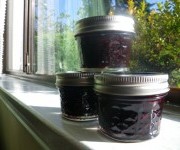I have a mystical sort of reverence for people who make their own jam. Like those who turn old pillowcases into cute outfits for their kids or whittle their own four-poster beds out of driftwood, their skills inspire both admiration and envy. What are my meager domestic accomplishments next to such down-home expertise? Jam seems advanced.
Lately, my inferiority complex has gotten worse. Jam-making used to live in the realm of Quaint Things Your Grandma Did, along with sewing buttons or knowing how to use a hat pin. Now it’s suddenly hip.
So in my newfound Greenie Pig spirit, I declared that I, too, would turn the season’s bounty into a luscious fruit spread that would last through the winter. Bonus: If it worked, I’d be able to shower my friends and family with jars of homemade goodness this holiday season.
As home preserving tasks go, making jam is probably one of the easiest. But thanks to a healthy fear of messing up the process (Merry Christmas! It’s botulism!) I decided to learn from a professional. A green home store in my neighborhood offers introductory classes, so I headed over on a recent Saturday, notebook in hand.
The instructor made it all look so simple. She demonstrated how to make two different kinds of jam (raspberry and mixed fruit), deftly stirring, sugaring, and boiling a multitude of pots and jars with nary a drop spilled. She had seven or eight perfect jars finished inside of 45 minutes.
As soon as class ended, I excitedly stocked up on supplies: regular jars, mini jars, all-purpose pectin, and a jar-lifting apparatus, reminiscent of a speculum, for moving the jam in and out of the boiling pot. (The recommended jar funnel I nixed, reasoning, “Pouring boiling-hot fruit mash from a pot into a tiny jar? How tough can that be?”) It all came in at less than $35.
That just left the fruit. This being October, I could have stocked up on pears or apples. But I see your local farmers-market fare and raise you one: fresh-picked blackberries. I’ve been researching urban foraging, too, and couldn’t resist the idea of harvesting some late-ripening specimens myself from a hillside just 10 minutes from the front door. It was tough work — the choicest blackberries were guarded by formidable thorns and spiderwebs of Tolkienesque proportions — but I managed to fill my Tupperware container with the three cups my recipe required.
Back at home, I thoroughly washed the fruit. Urban foragers are (rightly) very concerned about pesticides, but honestly, what worries me more is pee. (Hey, if a urine-powered prank has crossed my mind, surely it’s crossed the mind of some little punk, too, okay?) But after I rinsed the berries and set them out to dry, yet another foraging hazard crawled to the surface: two tiny, whitish grubs. I thought of all the blackberries I’d eaten straight from the bush last summer and felt a bit queasy.
A quick Googling session reassured me that blackberry grubs are common and, while kinda disgusting, can be cleared out by soaking the berries in salt water. After a salt-water soak and washing and rinsing the bounty yet again, I saw no sign of insect invaders.
It was time to get down to business. Following my recipe carefully, I mashed the blackberries into a pulp with a fork, then brought them to a boil on the stove. After 10 minutes or so at a hearty boil (ya like that, bacteria?), in went the sugar and pectin. One rolling boil and a spoon test to judge thickness later, and the whole mess actually looked like jam.
I spilled only a few gobs while transferring the hot jam into my jars (Funnels are for the weak!) and then wiped the rims clean. Lids went on, then I plunged each sealed jar into a stock pot of boiling water. Another five to 10 minutes of boiling ensured a tight seal and further eased my mind about lingering traces of mold or, OK, pee inside the jars. The finished jam looked downright professional.
Then my boyfriend came home. “You made jam?” he asked, inspecting the nearest jar. “Are you sure there’s no botulism in there?”
After I explained the process, he was game to try some. Bless his heart: He popped open the lid, sampled straight from the spoon, and pronounced it delicious.
Just don’t tell him about the grubs.
Next up: DIY carbon offsets. We’re taking a carbon-spewing flight to Texas in a few weeks for a friend’s wedding, and I’m determined to make up for the emissions myself. Not with dubious carbon offset purchases, but by nipping and tucking my carbon footprint back home. How long does it take to compensate for a Seattle to Austin to Marfa round-trip? We’ll find out.




